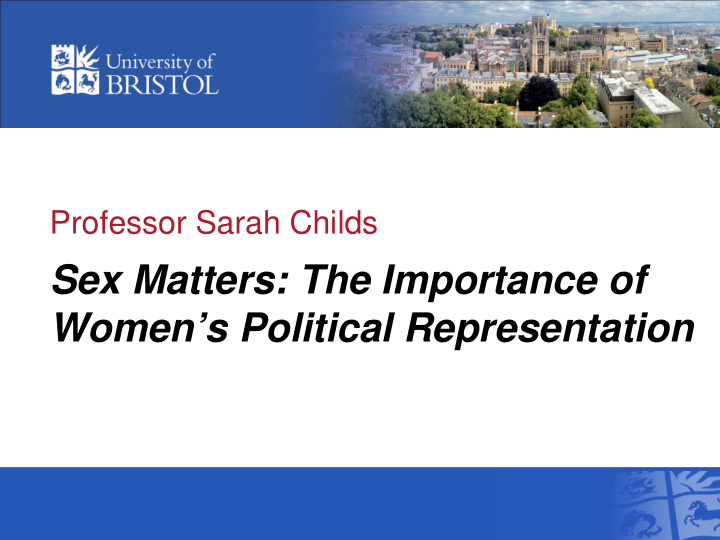



Professor Sarah Childs Sex Matters: The Importance of Women’s Political Representation
Virginia Sapiro • Why should I wish to be represented by a woman, indeed, a redheaded woman? • I could say … that such a person, resembling me, would represent my interest. • And how do you know that? • Because she is in the same position I am and could act for me. She would understand and feel the same way • When you say ‘the same position’, do you mean as a woman or as a redhead? • As a woman of course. • Why as a woman and not as a redhead? • Because being a redhead is not politically relevant and being a woman is
Arguments for women’s political presence 1. Justice 2. Symbolic representation (role model) 3. Acting for (link descriptive/substantive) 4. Style [amended Phillips 1995 and Lovenduski 1997]
Mansbridge 1999, 628 In at least four contexts, for different functions , disadvantaged groups may want to be represented by ‘ descriptive representatives 1. Adequate communication in contexts of mistrust [SRW] 2. Innovative thinking in contexts of uncrystallized, not fully articulated interests – improve deliberation [SRW] 3. Creating a social meaning of ‘ ability to rule ’ 4. Increasing polity ’ s de facto legitimacy in contexts of past discrimination
Regional Average Single or Single or Lower House: Lower House Regional Averages (IPU) Nordic 42.1% Americas 25.0% Europe Including Nordic 24.7% Europe Excluding Nordic 23.1% Sub-Saharan Africa 22.4% Asia 18.2% Arab States 17.8%
www.ipu.org rank Country % Rank Country % 1st Rwanda 63.8% 59th UK 22.5% 4th Sweden 45% 39th France 26.9% 7 th Finland 42.5% 80th st USA 17.8% 8 th South Africa 42.3% 88th Ireland 15.7% 12 th Mozambique 39.2% 118 th Brazil 8.6%
Political Recruitment 1992- 2010, by Sex, UK Parliament 700 600 500 400 men Women 300 200 100 0 1992 1997 2001 2005 2010
Numbers of UK Women MPs 1997-2010, by Party 160 140 120 100 LibDem 80 Consv Labour 60 40 20 0 1997 2001 2005 2010
Determinants of Descriptive Representation • Socio-economic • women’s participation in the public sphere and ‘pipe- line’ professions; social-democratic state • Cultural • measures of egalitarianism; secularism; date of women’s enfranchisement • Political • PR; positive discrimination; women’s presence in party hierarchies; left wing parties; centralized party selection processes; salience of ‘women’s vote’
Supply and Demand Supply • ‘outcome reflects supply of applicants ’ • Fewer resources: time, money, ambition, confidence, experience Demand • ‘selectors choose candidates depending on their perceptions of the applicants’ abilities, qualifications and experience’ • Direct discrimination • Indirect discrimination – what constitutes good MP • Imputed – perception that voters may discriminate 10
3 Strategies • Equality Rhetoric: • Public acceptance of claims for representation, • Equality Promotion: • Attempts to bring those who are currently under-represented into political competition • Equality Guarantees: • Measures that, all other things being equal, guarantee the selection and election of women 11
Quotas http://www.quotaproject.org/system.cfm#constnational Quota Type Definition Examples Quota provisions Burkino Faso, Nepal, Constitutional mandated in Phillipines, Uganda quota constitution Quota provisions in Latin US, Belgium, Election law national legislation or Bosnia Herzogovina, quota regulations Sudan Rules or targets set by Argentina, Bolivia, Political party political parties Ecuador, Germany, quota Norway, Italy, Sweden, South Africa, UK
Reconsidering Quotas: Opponents claims • Unnecessary as numbers will increase • Insufficient numbers of qualified women • Undermine principle of merit • (s)elected women will be stigmatized • (s)elected women will be tokens, dependent upon husbands/fathers
Critical Mass 1. With an increase in relative numbers: minority members are potentially allies, can form coalitions and affect the culture of the group 2. … minority members begin to become individuals differentiated from each other 3. Despite lack of change in relative numbers, two is not always large enough number to overcome the problems of tokenism …unless the tokens are highly identified with their own social group
Childs and Krook Rethinking SRW 1. From when women make a difference to how the substantive representation of women occurs 2. Refocusing the investigation from the macro level (ie, what do ‘women’ do?) to the micro-level (ie, what do specific women do?)
Recommend
More recommend